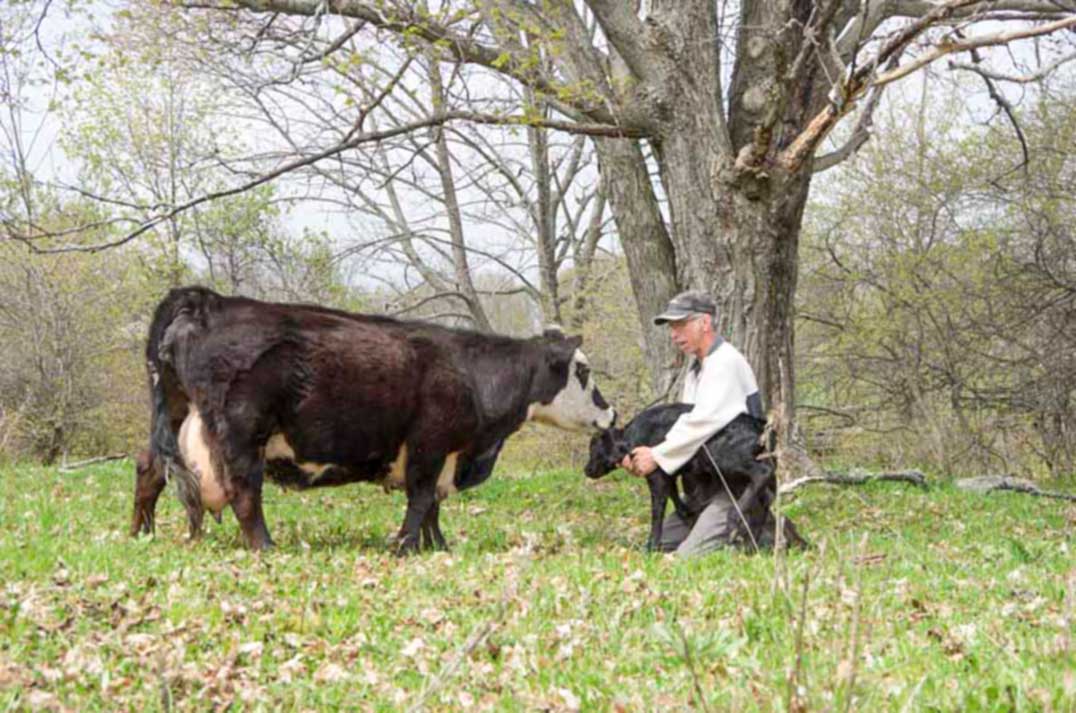ICE LAKE—Anyone passing the Max Burt farm in Ice Lake and noticing the cattle in his barn yard might wonder why some of the cattle are decidedly smaller than others.
“We have some Irish Dexter cattle, which are a miniature registered breed beef type,” Mr. Burt told the Recorder. “They actually originated in South Africa but are more commonly known as being from Ireland.”
Dexters are classified as a small, friendly, dual-purpose breed used for milk and beef. However, they are often listed as triple-purpose breed, since they are also used as oxen. Management practices vary by breeder and by country. Their versatility is one of their greatest assets, and probably has something to do with the number of countries Dexter cattle are found, including North America, South Africa, Australia, and much of Europe.
Dexter cattle are a breed of miniature cattle originating in Ireland. The smallest of the European cattle breeds, they are about half the size of a traditional Hereford and about one-third the size of a Friesian (Holstein) milking cow. A rare breed until recently, but are now considered a recovering breed by The Livestock Conservancy.
The Dexter breed originated in southwestern Ireland from which it was brought to England in 1882. The breed virtually disappeared in Ireland, but was still maintained as a pure breed in a number of small herds in England and also in the US.
Considering their small size, the body is wide and deep with well-rounded hindquarters. Dexters come in three colours: black, red and brown. Dexters should have no white markings except for some very minor white markings on the belly/udder behind the navel and some white hairs in the tail switch.
While many Dexters are naturally hornless (polled), many have horns that are rather small and thick and grow outward with a forward curve on the male and upward on the female. The breed is suitable for beef or milk production, although individual herd owners often concentrated on growing either one or the other. They are a cow whose hooves need trimming periodically, unlike other breeds.
“Although they have multiple purposes I’ve selected them for beef instead of dairy, but they still have high milking ability,” said Mr. Burt. “One of these animals will put out as much milk as other breeds of cattle.
Mr. Burt explained, “I built my herd from my dad’s herds, long before we even bought our farm. I could have got rid of that original calf in the herd, but at first I kept it as more of a hobby within my pasture field. They seem well adjusted to the area.”
“And I now have customers who ask for the Dexter cattle product directly. “They have a nice texture and their flavour is as good or better than larger size cattle beef,” said Mr. Burt.
Mr. Burt said that Dexters can provide another avenue for customers as their per side weight (dressed) is much smaller than other breeds. “Customers don’t have to put out significant dollars for a very large side of beef from other cattle breeds.”
He currently has 15 Dexters in his cattle cows in his herd. “This is a separate entity from my main herd of cattle.”
“Farmers can produce more pounds of beef per acre with the Dexter breed, than others (because of their size),” said Mr. Burt. “They are smaller and more efficient. Other producers have 1,600 pounds of beef cattle to deal with, while with the Dexter cattle I raise them to at an extreme, 700 pounds.”
Mr. Burt explained, “one of the things I like best about the Dexters is that they are docile, friendly and easy to handle.”
Irish Dexters are much smaller and therefore more homestead sized than common cattle breeds. A mature cow of this unique line averages around 600-800 pounds.
“I think that with their size and efficiency, it is another product line for people to consider when purchasing beef,” continued Mr. Burt. “And they are around 120-150 pounds per side so they are half the size of others.

“One of the challenges we’re facing as farmers-producers in Canada is that we are reaching almost the level of the US in that about 60 percent of our beef is being used as hamburger. That’s very unfortunate because we devaluate the product of a better eating experience such as a roast or steak when we have rates this high. And as a (cattle) carcass size grows the amount of meat that is being used up for hamburger is going up as well. Larger doesn’t make for a better product. If consumers are looking for good eating and a better portion of beef in terms of beef product to fat, this type of animal provides that.”
“I can cut an eight ounce steak out of one-quarter inch beef, which is better on the plate,” said Mr. Burt. “And they provide for flavourful, tender and juicy meat. And the customer is getting good value, especially if they want a high meat to bone ratio.”
Mr. Burt also pointed out Dexters have great mothering instincts which they display when protecting the young animals against predators. “Although they are very docile with a pleasant temperament they can still be aggressive when guarding their young. If a coyote for instance goings after a calf, they will wish they hadn’t-this breed of cattle are really protective of their calves.”